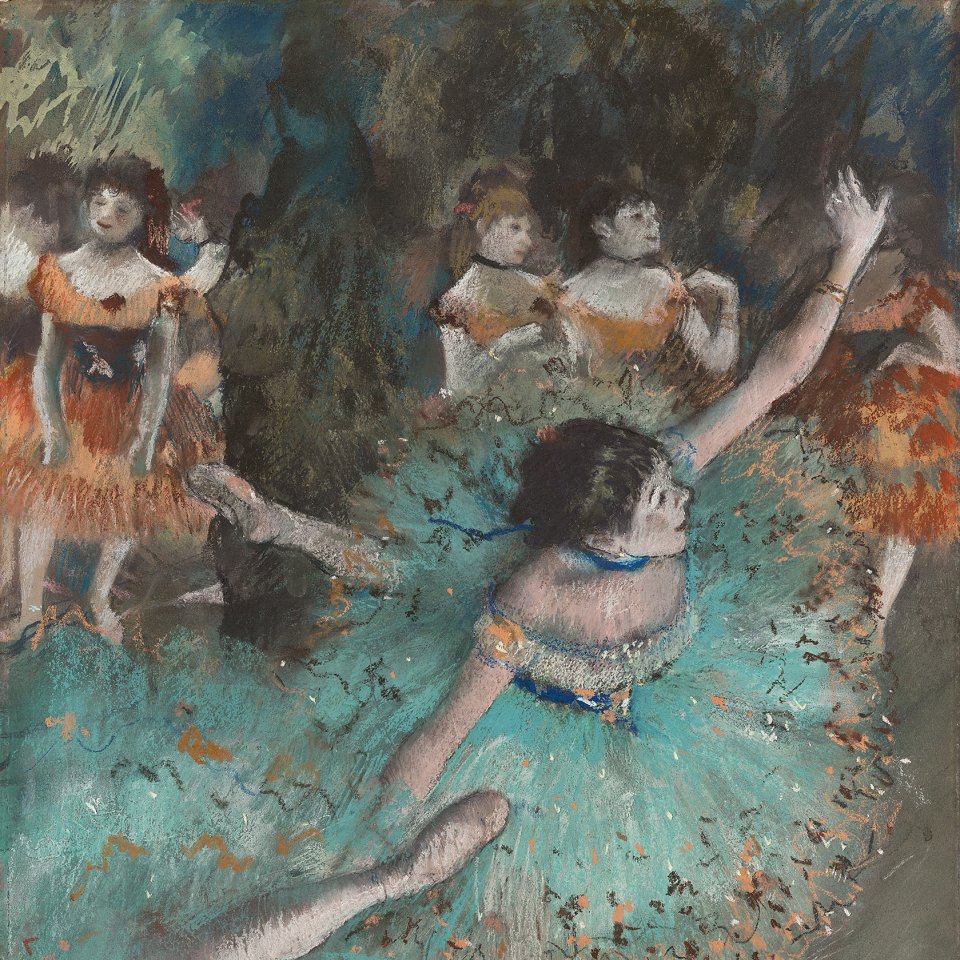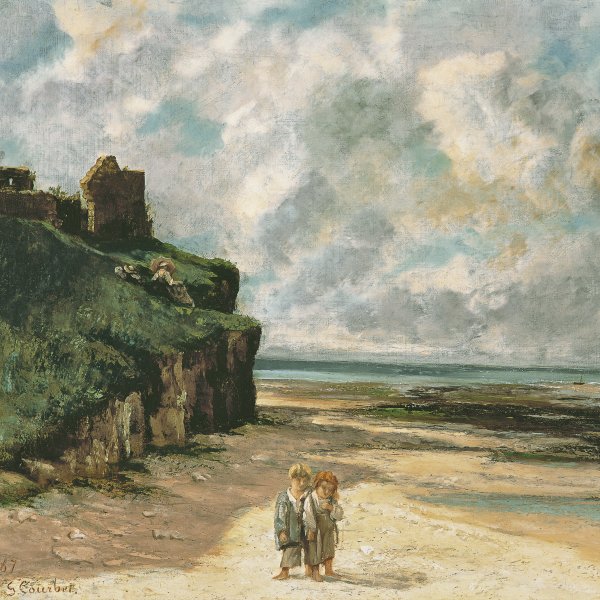The Water Stream, La Brème
1866
Oil on canvas.
114 x 89 cm
Museo Nacional Thyssen-Bornemisza, Madrid
Inv. no.
495
(1986.2
)
ROOM 33
Level 1
Permanent Collection
“I also hold that painting is a quite concrete art, and can consist of nothing but the representation of real, tangible things, ” wrote Gustave Courbet in an open letter to his students in 1861, deliberately eschewing the mythological or historical themes that were predominant in painting at the time. The artist, who proclaimed himself to be anti-academic, progressive and social, believed neither in unique beauty nor in the sublime, and his sole source of inspiration was his encounter with nature. In The Meeting: Bonjour Monsieur Courbet, executed in 1854, the artist portrays himself with his belongings packed on his back, ready to go out into the countryside to paint, in order to make a clear statement about the new image of the painter who ventures forth into the outside world in pursuit of subject matter and, in addition, to acknowledge landscape as a genre in its own right, a genre that combined his realist ideas and his keen love of nature.
In the opinion of Courbet, who belonged to the generation of Post-Romantic artists, the only valid criterion when it came to painting was the artist’s own experience, which enabled him to create a visual equivalent capable of conveying certain meanings of reality to others. He thus brought a fresh appreciation of the artist’s subjectivity, a ground that had been prepared by the Romantics. Courbet subscribed to Emile Zola’s famous view that “a work of art is a corner of creation seen through a temperament, ” and the ideas of Champfleury, the main advocate of Realism, who proclaimed that “the reproduction of nature by man’s hand will never be a reproduction or imitation, but always an interpretation.”
With its groundbreaking ideas, Monsieur Courbet brought about a transformation not only in the language of painting but also in the very role of the artist. He furthermore adopted Realism as his political standard and his radical ideas triggered a major revolution. He might be described as the first avant-garde artist who consciously defied the established norms and did not hesitate to set up his own pavilion after being turned down by the Salon of 1855. Inside this hut, which was announced with a large sign bearing the word Realism, he exhibited The Studio, one of his masterpieces and a manifesto of his painting. As could only be expected, in this emblematic work the artist portrayed himself painting a landscape in his studio together with a large group of acquaintances.
The Water Stream, La Brème was executed during the final stage in his career. This landscape scene of the environs of Ornans, his birthplace, shows a place in the forest called Puits Noir (Black Well), where the small stream of La Brème spouts from among the rocks amid leafy vegetation. The painter sets out to capture the particular characteristics of the scenery with utmost trueness to life, yet retaining his subjective conception of painting. He produces a skilful study of the play of the sunlight filtering through the trees and casting its reflections on the calm surface of the deep, black waters of the pool and masterfully conveys the silent atmosphere of this spot. He combines large patches of colour executed with rapid, loose brushstrokes with areas in which the paint is applied with a palette knife using a very solid technique that reinforces the painter’s realist language. His concern for the materiality of the surfaces is also evident from his avoidance of spatial depth, which foreshadows Impressionist painting. The background appears close to the viewer in order to make the different textures of the rocks, the mountains and the water more palpable in his attempt to imitate the corporeality of nature through the corporeality of painting.
The scenery of the Franche Compté with its rocky mountains, dense trees and small rivers and waterfalls, imbued with great sensuousness, was a very common motif in Courbet’s work during those years. The manner in which the water springs from the openings and small caverns in the rocks, together with the artist’s fascination with secluded places, has led these landscapes to be interpreted as sexual metaphors by some modern scholars, who link them to the expression of erotic themes in terms of landscape, such as the Origin of the World.
Paloma Alarcó
In the opinion of Courbet, who belonged to the generation of Post-Romantic artists, the only valid criterion when it came to painting was the artist’s own experience, which enabled him to create a visual equivalent capable of conveying certain meanings of reality to others. He thus brought a fresh appreciation of the artist’s subjectivity, a ground that had been prepared by the Romantics. Courbet subscribed to Emile Zola’s famous view that “a work of art is a corner of creation seen through a temperament, ” and the ideas of Champfleury, the main advocate of Realism, who proclaimed that “the reproduction of nature by man’s hand will never be a reproduction or imitation, but always an interpretation.”
With its groundbreaking ideas, Monsieur Courbet brought about a transformation not only in the language of painting but also in the very role of the artist. He furthermore adopted Realism as his political standard and his radical ideas triggered a major revolution. He might be described as the first avant-garde artist who consciously defied the established norms and did not hesitate to set up his own pavilion after being turned down by the Salon of 1855. Inside this hut, which was announced with a large sign bearing the word Realism, he exhibited The Studio, one of his masterpieces and a manifesto of his painting. As could only be expected, in this emblematic work the artist portrayed himself painting a landscape in his studio together with a large group of acquaintances.
The Water Stream, La Brème was executed during the final stage in his career. This landscape scene of the environs of Ornans, his birthplace, shows a place in the forest called Puits Noir (Black Well), where the small stream of La Brème spouts from among the rocks amid leafy vegetation. The painter sets out to capture the particular characteristics of the scenery with utmost trueness to life, yet retaining his subjective conception of painting. He produces a skilful study of the play of the sunlight filtering through the trees and casting its reflections on the calm surface of the deep, black waters of the pool and masterfully conveys the silent atmosphere of this spot. He combines large patches of colour executed with rapid, loose brushstrokes with areas in which the paint is applied with a palette knife using a very solid technique that reinforces the painter’s realist language. His concern for the materiality of the surfaces is also evident from his avoidance of spatial depth, which foreshadows Impressionist painting. The background appears close to the viewer in order to make the different textures of the rocks, the mountains and the water more palpable in his attempt to imitate the corporeality of nature through the corporeality of painting.
The scenery of the Franche Compté with its rocky mountains, dense trees and small rivers and waterfalls, imbued with great sensuousness, was a very common motif in Courbet’s work during those years. The manner in which the water springs from the openings and small caverns in the rocks, together with the artist’s fascination with secluded places, has led these landscapes to be interpreted as sexual metaphors by some modern scholars, who link them to the expression of erotic themes in terms of landscape, such as the Origin of the World.
Paloma Alarcó
Emotions through art
This artwork is part of a study we conducted to analyze people's emotional responses when observing 125 pieces from the museum.
Joy: 77.38%
Disgust: 6.51%
Contempt: 0%
Anger: 0%
Fear: 0.22%
Surprise: 0.47%
Sadness: 15.42%














